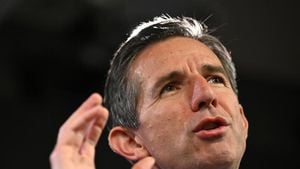NASA is currently grappling with unexpected challenges as astronauts Sunita Williams and Butch Wilmore face indefinite delays returning from the International Space Station (ISS). Initially planned for just eight days, complications with the Boeing Starliner spacecraft have extended their stay, potentially lasting until early 2025.
This situation has triggered serious concerns about the astronauts' health and the broader impacts on future space missions. Technical difficulties, including helium leaks and thruster failures, have put the Starliner’s safety under scrutiny.
Williams and Wilmore have been living aboard the ISS under less than ideal conditions, improvising as best they can with limited sleeping arrangements. Wilmore now sleeps on the floor of the Japanese module Kibo, using only his sleeping bag, as there's simply not enough room for everyone.
On the other hand, Williams makes use of the Crew Alternate Sleep Accommodation (CASA), sharing space with another crew member. Their initial excitement about the mission has begun to wear thin as they adapt to daily chores rather than conducting scientific research.
Maintaining the ISS itself has required their hard work, including tasks like repairing the urine processing system, which adds to the reality of their extended stay. Limited clothing options have also presented challenges; they initially packed only enough attire for their brief mission but received fresh supplies from the latest Northrop Grumman resupply mission.
With the future of Starliner uncertain, NASA has been discussing alternatives for the astronauts' return. If these issues persist, they may be returned via SpaceX's Crew Dragon, which is slated for launches as early as September.
Uncertainty about return dates has increased, with some estimates stretching as far out as February 2025. This could mean they could spend nearly eight months living and working on the ISS, much longer than initially planned.
Navigational caution is at the forefront for NASA officials, who are well aware of the risks involved with extending missions after previous tragedies like the Challenger and Columbia disasters. Russ DeLoach, Chief of Safety and Mission Assurance, emphasized the importance of considering every safety aspect before making any decisions.
While confined to the ISS, the psychological toll of prolonged isolation is also being monitored. The astronauts may face emotional and physical challenges due to the extended nature of their stay, particularly as time slips away.
Researchers have previously studied how prolonged situations can distort the perception of time. For most, the experience of waiting can feel torturous, and for astronauts, the stakes are significantly higher.
Dr. Bhupesh Kumar, specializing in brain health, expressed concerns about the potential cognitive risks astronauts might face during extended missions. Hypoxia, when the brain doesn’t get enough oxygen, can lead to memory loss and long-term neurological problems.
Cosmic radiation presents another layer of risk, compounding potential health issues—tests and monitoring become critical as the crew spends more time exposed. Dr. Shailesh Jha elaborated, pointing out how fluid shifts due to microgravity can increase intracranial pressure, resulting in severe headaches and visual issues.
Meanwhile, stress levels among the astronauts can increase exponentially, leading to potential conditions like PTSD from being isolated for so long. NASA is committed to keeping the astronauts informed on the spacecraft's readiness and addressing any health issues as they come up.
Despite their situation, both Wilmore and Williams have managed to uphold their optimistically. Reports indicate they handle their challenges with humor and camaraderie, which helps maintain their spirits high even during uncertain times.
Future missions may benefit significantly from the experiences of these astronauts, particularly when it involves complex spacecraft operations like the Starliner. Their resilience and adaptability will likely provide valuable data for improving future operations and disaster preparedness.
Families and loved ones at home are waiting anxiously for any updates from NASA, hoping for their loved ones' safe return. They watch closely as each announcement rolls out, glancing at future launch schedules and developments.
Looking closely at their situation reveals significant insights about the nature of space travel. The challenges faced by astronauts are not only technical but emotional and psychological; NASA's focus is on crafting better strategies for carrying out long-term missions.
The saga of Williams and Wilmore is not just about their struggles but highlights the unpredictable nature of space exploration and the need for resilience among missions. How they tackle these challenges could shape the future of human endeavors beyond Earth and facilitate better strategies for handling unexpected turns.
The story brings to light the complexity of sending humans to space and serves as both cautionary and hopeful narratives. Space agencies hope for the astronauts' safe return, promising to minimize risks and increase overall mission safety.
Lessons learned from this mission will go on to refine protocols, ensuring the safety and well-being of all astronauts who dare to venture out of Earth's atmosphere.



